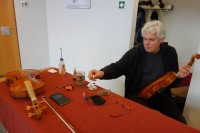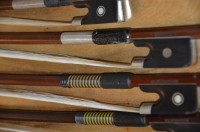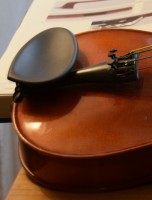
Tips and tricks for the care and maintenance of the viola |
How to avoid damage
by Mascha Seitz
Isn’t it wonderful to take an excellently preserved and well-kept viola into your hand, to look at it from all sides and to admire the beauty of this instrument? You haven’t got to be a trained violin-maker to handle a viola carefully.
 In a former article, we talked about the right posture and about how to stay fit as a musician. This and the following articles are about how you can treat your viola equally well. With the right care, you will be glad whenever you take your instrument into your hand. We give you tips about upkeep and maintenance of the instrument (and we also advise you of cases, which you should better not attend to by yourself).
In a former article, we talked about the right posture and about how to stay fit as a musician. This and the following articles are about how you can treat your viola equally well. With the right care, you will be glad whenever you take your instrument into your hand. We give you tips about upkeep and maintenance of the instrument (and we also advise you of cases, which you should better not attend to by yourself).
Damage avoidance, storage and the well-tempered viola
Environmental influences such as wetness, heat and dry air do no good to any string instrument. Therefore, you would be well-advised not to leave your instrument in summer in your car. Wetness is poison to the viola, but too dry air can damage it as well. If it is kept for a long period in a dry place (e.g. near the floor heating or near a stove) with an air humidity of less than 45 percent, this will permanently lead to cracks in the wood or it will damage the glue joint. Therefore, the instrument should not be stored in heavily heated rooms. You can even fall back on a sort of «viola humidor», a Dampit (a moistened rubber hose, where the viola is placed into). It is easier though to use a room humidifier or to choose a room with regularly watered houseplants inside. However, one thing that you absolutely should avoid are sudden temperature changes. If your instrument in winter has just been in a cold place, you should not immediately take it in your hand and play it inside the warm flat. Instead, let the viola acclimatise for a while inside the viola case. Of course, the same is true of hot days, if you step into a cool room.
However, one thing that you absolutely should avoid are sudden temperature changes. If your instrument in winter has just been in a cold place, you should not immediately take it in your hand and play it inside the warm flat. Instead, let the viola acclimatise for a while inside the viola case. Of course, the same is true of hot days, if you step into a cool room.One more tip about the storage: you should cover the instrument with a cloth to prevent the frog of the bow from scratching your instrument’s varnish inside the viola case. It is also possible to wrap up the frog itself. Still, a complete cover between the bow and the viola would be better, also because it would avoid any contact with the rosin, which damages the varnish of the viola.
Cleaning the viola regularly
It really is advisable to clean the viola every time you have played it, because otherwise there could occur problems with the varnish. When the bow strokes the strings, finest rosin dust will trickle continuously onto the instrument’s surface. Initially, this dust is invisible. However, it will leave a white layer on the varnish, if you clean the viola too rarely. If you don’t clean the viola at all, you run the risk that the rosin can hardly be separated from the varnish any more. It is advisable to use a dry, lint-free and soft cloth to remove the dust. Please just clean the concerned spot and avoid distributing the dust on the whole instrument overeagerly, which can result in minor scratches and impurities.
It is advisable to use a dry, lint-free and soft cloth to remove the dust. Please just clean the concerned spot and avoid distributing the dust on the whole instrument overeagerly, which can result in minor scratches and impurities.The strings themselves should be cleaned regularly (although not every day). Also regarding the strings, the rosin dust can permanently have consequences and make them difficult to play.
Therefore, for cleaning the strings we recommend you to put some alcohol (isopropyl alcohol from the pharmacy or simply methylated spirit from the chemist’s) on a cloth or on a piece of kitchen paper, yet the cloth should not drip. Measure out the alcohol thriftily, a few drops are enough. While cleaning the strings, you should not exert too much pressure in order to prevent the cloth from dripping. Try to secure with the other hand from below, because the alcohol would damage the varnish.
 The chin-rest and the fingerboard can also be cleaned in this way, if the fingerboard is made of ebony (please don’t use alcohol with stained boards). Afterwards you can do something good to your instrument by polishing up its fingerboard with linseed oil or olive oil.
The chin-rest and the fingerboard can also be cleaned in this way, if the fingerboard is made of ebony (please don’t use alcohol with stained boards). Afterwards you can do something good to your instrument by polishing up its fingerboard with linseed oil or olive oil.By cleaning the parts of the viola you are constantly in contact with regularly, you can also prevent inflammations of your fingertips and neck (fiddler’s neck).
Dust also gathers in the viola’s body itself. It can be removed by a small amount of rice that you scatter into the F-holes. Now you shake the instrument, which results in the grains of rice absorbing the dust and cleaning the instrument from the inside.
Cleaning the varnish
 Ideally you spare your instrument’s varnish by touching the instrument just by its neck, but not by its body, and by preventing the body’s varnish from contact with hand perspiration. Even washed hands contain sweat and fat compounds that damage the varnish.
Ideally you spare your instrument’s varnish by touching the instrument just by its neck, but not by its body, and by preventing the body’s varnish from contact with hand perspiration. Even washed hands contain sweat and fat compounds that damage the varnish.Never use commercially available furniture polishes or cleaning agents, because these may contain solvents that damage the varnish.
For cleaning the varnish, there are some special polishing agents and cleaning products for varnish. However, you should not overuse them, because if you do so, the wax components, which give your viola the desired shine, can cause a separate layer on the varnish.
In case of persistent impurities, especially of the F-holes, the dirt has to be scraped off first and tackled with special cleaning agents afterwards. That should be done by the violin-maker.
Further tips and tricks for the care and maintenance of the viola
Hermann Ritter - Presentation: The Triple-Footed or 'Normal violin bridge' (German, Download, OpenAccess)
Posture caused problems in the viola play
10 tips how to motivate yourself for the daily practice
Practice or Talent?
Sources:
https://www.geige24.com/shop/wie-pflege-ich-meine-geige-tipps-und-tricks
http://www.geigenbau.com/tippsundtricks/geigenbau.php
http://www.corilon.com/shop/de/info/geige-tipps.html

Albrecht Löbner • Geigenbaumeister
Achauerstrasse 14
DE - 78647 Trossingen
www.Geigenbau-Loebner.de
New • for students |

» To the 'Old Age'...

» To the Virginia-Romance...
New • for professionals |

Blog overview |
The blogs in a short overview.
» To the blog list
Newsletter |
 Do you don't want to miss any news regarding viola anymore? Our newsletter will keep you informed.
Do you don't want to miss any news regarding viola anymore? Our newsletter will keep you informed.» Subscribe to our Newsletter for free
|
|
 Visit and like us on Facebook.
Visit and like us on Facebook.» Music4Viola on Facebook